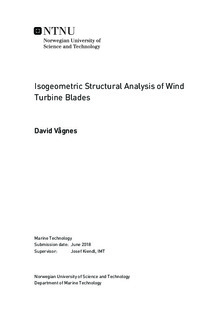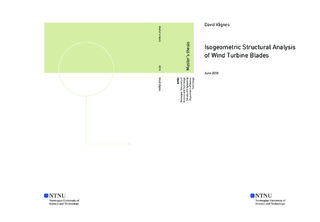| dc.description.abstract | Isogeometric analysis, IGA, seeks to bridge the gap between engineering design and computational analysis by using spline functions as finite element bases in the analysis framework. The general concept can be applied to all fields of engineering mechanics, and has proven to perform with great accuracy and efficiency. In computer-aided design, CAD, NURBS has become the standard technique for representing exact geographical shapes like circles, spheres and cones, as well as free form curves and surfaces, which are fundamentals in geometry modelling. In the finite element method, FEM, the geometry model is typically represented by small finite element in a mesh, which is analyzed several sub-problems. The basis functions used in the analysis is typically based on simple Lagrange polynomials, whereas the design framework utilizes smooth spline functions. For awkward shaped structures, this conflict accounts for more than 80\% of the overall design-analysis time. By utilizing the same NURBS basis functions in analysis, the meshing procedure is omitted and the exact geometry model created in CAD can be subject for analysis.
The use of wind turbines for electricity generation is increasingly common, and offshore wind turbines has become an attractive solution in the industry. Due to the large areas available and cost related to offshore installation, there has been a continuous upscaling of wind turbines. This has created a need for the DTU 10MW reference wind turbine, which has the scope of acting as benchmark for new wind turbine designs. In this thesis, one of the DTU 10MW RWT blades will be modelled subject for structural IGA.
The mathematical formulation of NURBS is presented, where important features to its development is pointed out. In finite element analysis, mesh refinement is used to converge and validate the solution by resolving the model with successivly finer and finer mesh. Theory behind a unique method for refining the NURBS model with respect to IGA is presented as a solution to FEM mesh refinement. Data is retrieved from the repository accompanying the reference wind turbine, and the commercial NURBS-based software Rhino is used as a tool for modelling of the NURBS model. A procedure is obtained to import a coarsen multipatch model to the IGA research code in Matlab.
In this thesis, a NURBS-based Kirchhoff-Love shell formulation is utilized for structural analysis of the blade model in IGA. Important features about the rotation-free shell formulation is pointed out, where two methods for multi patch coupling is used. Two different methods for multipatch coupling is investigated, where the first is coupling by penalty method for unmatching patches and the second is bending strip method. Furthermore, classical lamination plate theory is used to obtain the laminate stiffness matrix in the analysis.
The origin of the material parameters for the plies in the reference wind turbine blade is presented through the micromechanics equations, together with composite lamination theory. Regional layup for the blade is presented, and a procedure for defining the regions is added to the code. Also, a stiffness function is adapted to compute the stiffness of the evaluated points in the analysis, where classical laminate theory is used to model the composite laminate material of the structure under consideration.
The stiffness function adapted in the IGA code is compared to a benchmark of a multistack and multidirectional laminate. Furthermore, the two coupling methods are compared for a simplified analysis, which in addition to controlling the unmatching patches challenge, also shows one of the advantages of IGA, where a modified geometry does not need a new meshing procedure. Finally, a corresponding FEM analysis in Abaqus with two different load cases is compared to the full IGA model in terms of accuracy and efficiency. The displacement pattern in general and tip deflection particularly for the two analyzes, shows that the IGA model performs with great accuracy and efficiency. With significantly fewer degrees of freedom, the tip displacement in IGA deviates with only 0.34\% from the reference solution. | |

